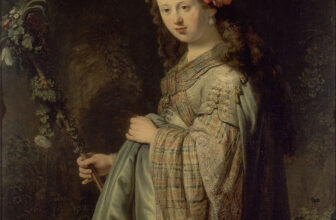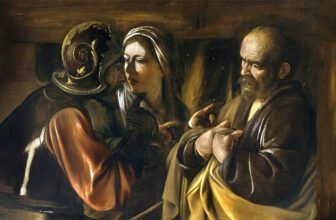
Meaning and Symbolism of Woman with a Water Jug
Johannes Vermeer is one of the most mysterious and fascinating figures in the history of Western art. Unlike some of his contemporaries who produced hundreds of paintings, Vermeer’s surviving body of work is astonishingly small, only about 34 paintings are attributed to him with certainty. Yet, within this small number, Vermeer achieved an unparalleled mastery of light, intimacy, and atmosphere. Among his masterpieces, one painting in particular, Woman with a Water Jug (c. 1660–1662), stands out as both deceptively simple and infinitely profound.
The painting depict a modest domestic scene: a woman in a quiet Dutch interior standing near a window, holding a water pitcher in one hand while the other rests lightly on the window frame. But as with nearly all of Vermeer’s works, beneath the apparent simplicity lies a rich layering of symbolism, cultural meaning, artistic innovation, and meditations on daily life.
This essay will explore the story of Woman with a Water Jug: what the painting shows, how it was made, its symbolism, and what it represents. By the end, it becomes clear why this work, though modest in size, remains a touchstone in art history.
The Story Behind the Woman with a Water Jug Painting Painting
Painted around 1660–1662 during Vermeer’s maturity as an artist, Woman with a Water Jug represents the essence of Dutch Golden Age painting: scenes of everyday life imbued with quiet dignity and symbolic richness.
The painting shows a solitary woman, likely in the privacy of her home, as she gently opens a window while holding a water jug. Her attire, consisting of a linen headdress and a finely colored dress with a rich blue jacket trimmed with fur, suggests that she is of a comfortable, respectable household. On the table beside her lies a decorative box and a large metal basin. A map faintly hangs on the wall behind her, and daylight pours through the window, bathing the room in Vermeer’s signature soft radiance.
The painting is not one of grand drama or mythological allegory but rather a moment of stillness, an ordinary act elevated into art. It is a woman preparing water, perhaps to wash her hands, as part of a morning ritual, or as an act of spiritual or moral cleansing.
Vermeer’s genius lies precisely in finding the profound in the ordinary. The act of lifting a jug becomes, in his hands, a meditation on purity, devotion, and the harmony between light and human presence.
How the Woman with a Water Jug Painting Was Made
Johannes Vermeer was renowned for his extraordinary technical skill, though his methods have been the subject of debate and fascination for centuries.
The Woman with a Water Jug was painted in oil on canvas and measures about 18 x 16 inches, a relatively small scale, which enhances the intimate effect of the scene. Vermeer’s palette was not broad, but he used pigments of the highest quality. Most famously, he employed ultramarine, a brilliant blue pigment derived from lapis lazuli imported from Afghanistan, which was one of the most expensive materials available to artists at the time. The woman’s blue jacket is a striking example of Vermeer’s willingness to lavish costly pigments on domestic subjects, demonstrating his respect for the dignity of everyday life.
His approach to light is what sets him apart most dramatically. Scholars have long debated whether Vermeer used optical aids, such as the camera obscura, to study the fall of light and perspective. While no definitive evidence exists, the precision with which he captured the play of light through windows suggests he may have at least experimented with optical devices.
In Woman with a Water Jug, Vermeer’s layering technique, delicate glazes over opaque underpaint, creates a luminous quality that makes the daylight seem to shimmer across surfaces. The glass window glows with reflections, the jug gleams softly, and the woman’s skin is bathed in gentle light.
The painting was carefully composed: the angle of the woman’s body creates a diagonal line leading toward the open window, which in turn allows light to guide the viewer’s eye back toward her face and hands. Everything feels balanced, yet nothing is rigid. Vermeer’s touch is meticulous yet full of life.
What the Woman with a Water Jug Painting Represents
Woman with a Water Jug represents a moment of daily domestic activity in a Dutch household. However, Dutch art of the 17th century was rarely just about literal representation. Domestic objects, gestures, and settings often carried symbolic significance, especially in the Protestant Netherlands, where moral lessons were subtly embedded in art.
The woman with the jug can be seen as representing purity, devotion, and temperance. Water, in Christian symbolism, is often associated with cleansing and renewal, both physically and spiritually. Her gesture of opening the window could represent a longing for fresh air, a connection to the outside world, or metaphorically, the openness of the soul to light and truth.
Furthermore, the quiet dignity of the woman reflects the cultural emphasis on the moral virtue of domestic life in 17th-century Dutch society. The home was considered the foundation of order and morality, and women played a central role in maintaining its sanctity. Thus, Vermeer’s painting is not only a portrait of one woman but also a reflection of ideals of womanhood, household, and virtue in his time.
Symbolism and Meaning
Every detail in Woman with a Water Jug can be interpreted symbolically:
The Water Jug and Basin – These objects were often associated with cleanliness and purity. Beyond physical washing, they could symbolize moral or spiritual cleansing. In the context of Dutch Protestant values, daily chores were infused with spiritual meaning, and the jug becomes more than a utilitarian object, it becomes a metaphor for inner virtue.
The Window and Light – Light in Vermeer’s work consistently symbolizes truth, knowledge, and divine grace. The woman’s act of opening the window can be seen as welcoming illumination, both literally and metaphorically. The soft daylight flooding the room creates a spiritual atmosphere, suggesting divine presence in ordinary life.
The Woman’s Attire – Her clothing, particularly the expensive blue jacket trimmed with fur, suggests not vanity but respectability. The use of ultramarine blue, a pigment often reserved for depictions of the Virgin Mary in earlier religious art, may subtly connect her with themes of purity and devotion.
The Map on the Wall – Maps were common decorative elements in Dutch homes, reflecting the nation’s global reach and pride in exploration. In this context, the map may symbolize the world beyond the domestic interior, the tension between the quiet household and the vast outside world.
The Act of Pausing – The woman seems caught in a moment of stillness, as if she has paused between two actions. This meditative pause imbues the scene with a sense of timelessness, suggesting reflection and contemplation.
What is Happening in the Woman with a Water Jug Painting?
The literal scene shows a woman holding a water jug and gently opening a window. Yet, the deeper “happening” is the transformation of this mundane action into a meditation on presence, light, and meaning.
We are witnessing not just a woman preparing water but the act of a person attuning herself to the light, to the world, and to her own inner life. This is the genius of Vermeer: he elevates the act of daily routine into something transcendent. Nothing extraordinary “happens,” yet everything happens, a quiet revelation of beauty and significance in ordinary existence.
The Woman with a Water Jug Type of Art
Woman with a Water Jug belongs to the category of genre painting, a form of art that depicts scenes of everyday life. In the Dutch Golden Age, genre painting flourished as an art form that celebrated the domestic, the ordinary, and the intimate.
However, Vermeer’s approach to genre painting was unlike that of many of his contemporaries. While others often emphasized humor, satire, or overt moral lessons, Vermeer brought a sense of serenity and transcendence to his subjects. His women are rarely caricatures or moral warnings but instead figures of quiet strength, dignity, and introspection.
Thus, while Woman with a Water Jug is technically a genre painting, it transcends the category by bordering on the spiritual, almost devotional.
Current Location of the Woman with a Water Jug Painting
Woman with a Water Jug is housed in the Metropolitan Museum of Art in New York City. It was the first Vermeer acquired by an American museum and remains one of the gems of the Met’s European painting collection.
Its presence in New York is significant because it was among the works that introduced Vermeer to a wider international audience during the 19th and 20th centuries. For centuries after his death, Vermeer had been largely forgotten, rediscovered only in the 19th century. Today, his works are considered priceless treasures, and Woman with a Water Jug is a highlight for millions of visitors to the Met each year.
Why the Woman with a Water Jug Painting Still Matters
Woman with a Water Jug resonates across centuries because it speaks to something universal: the beauty of ordinary life illuminated by attention and light. Vermeer shows us that in the most modest gestures, lifting a jug, opening a window, there can be profound meaning.
In an age of distraction, the painting reminds us to pause, to notice the light falling on a surface, to find dignity in the quiet rituals of daily existence. It is at once deeply historical, rooted in 17th-century Dutch culture, and timeless in its appeal.
Johannes Vermeer’s Woman with a Water Jug is far more than a simple depiction of a woman at a window. It is a profound meditation on light, purity, and the spiritual resonance of daily life. Painted with unparalleled technical mastery and imbued with layers of symbolism, it elevates the ordinary into the extraordinary.
Through the woman’s quiet gesture, Vermeer reminds us that meaning is not always found in grand events but often in the still, luminous moments of everyday life. Today, standing before the painting at the Metropolitan Museum of Art, viewers are invited into the same timeless pause that Vermeer captured over three centuries ago, a pause in which the ordinary becomes eternal.




